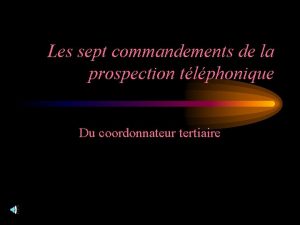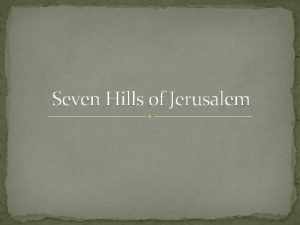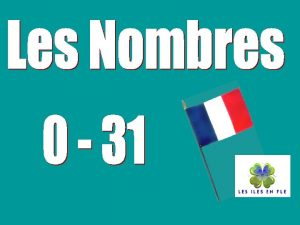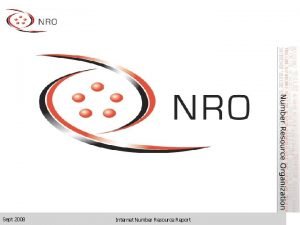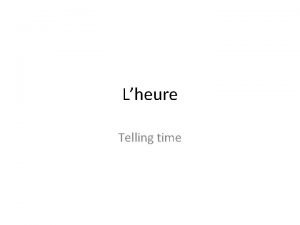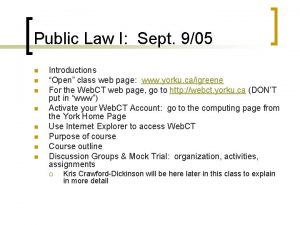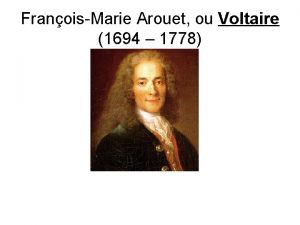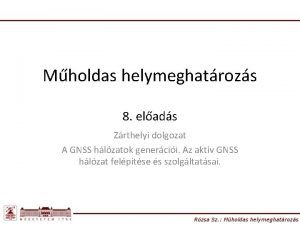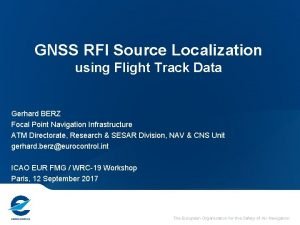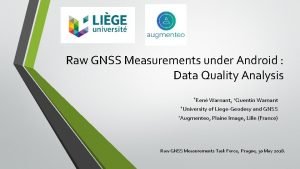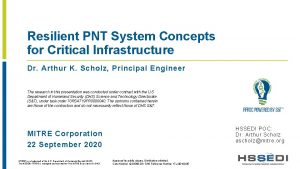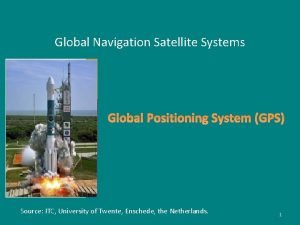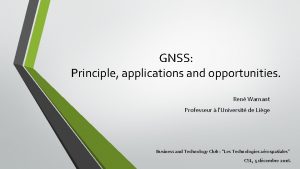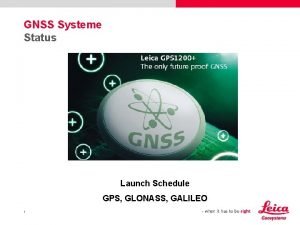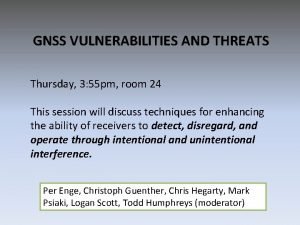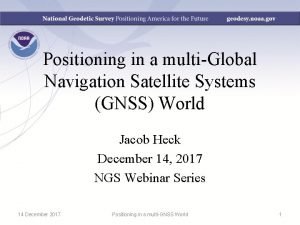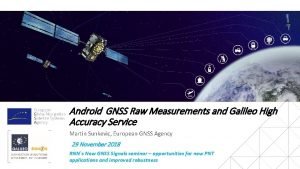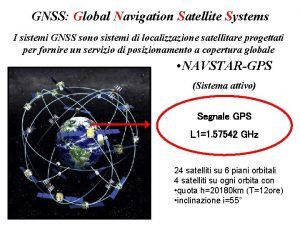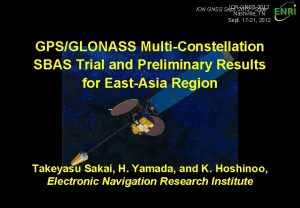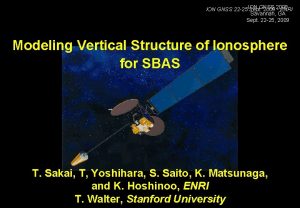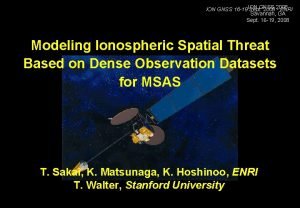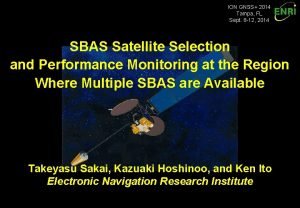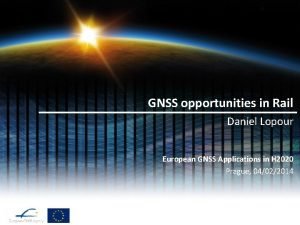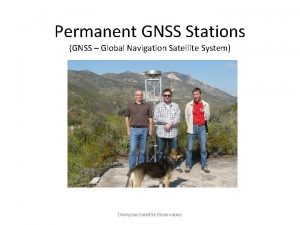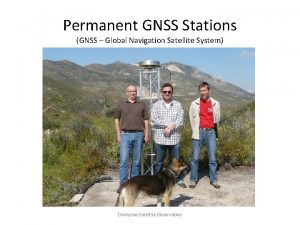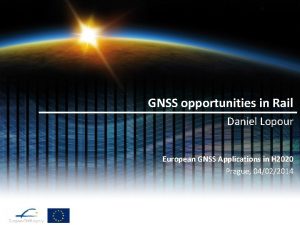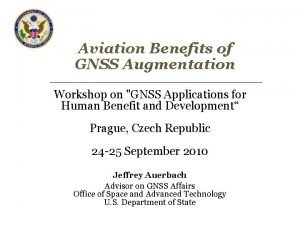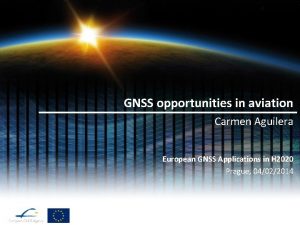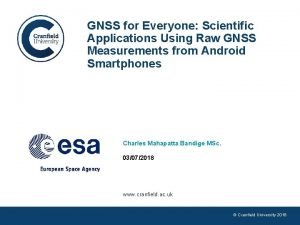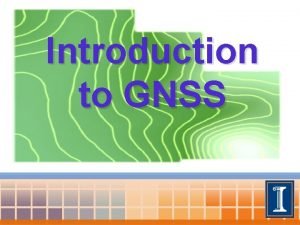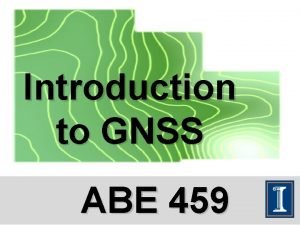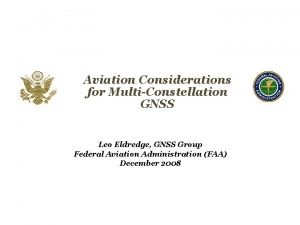ION 2012 GNSS 2012 ION GNSS Sept Slide

























- Slides: 25

ION 2012 GNSS 2012 ION GNSS Sept. - Slide Nashville, TN Sept. 17 -21, 2012 The L 1 -SAIF Signal How was it designed to be used? Takeyasu Sakai Electronic Navigation Research Institute

ION GNSS Sept. 2012 - Slide 1 Introduction • QZSS (Quasi-Zenith Satellite System) program: – Regional navigation service broadcast from high-elevation angle by a combination of three or more satellites on the inclined geosynchronous (quasi-zenith) orbit; – Broadcast GPS-like supplemental signals on three frequencies and Two Augmentation Signals, L 1 -SAIF and LEX; – The first QZS satellite was successfully launched on Sept. 11, 2010. • L 1 -SAIF (Submeter-class Augmentation with Integrity Function) signal: – Augmentation service on L 1 single frequency designed for mobile users; – Signal design: SBAS-like message stream on L 1 C/A code (PRN 183). • ENRI has been developing L 1 -SAIF signal and conducting experiments: – L 1 -SAIF Master Station (L 1 SMS) experimental facility installed at ENRI; – IS-QZSS contains specification of L 1 -SAIF signal as well as other signals.

ION GNSS Sept. 2012 - Slide 2 QZSS Concept GPS/GEO • • • Footprint of QZSS orbit; Centered at longitude of 135 E; Eccentricity 0. 075, Inclination 43 deg. QZS • Broadcast signal from high elevation angle; • Applicable to navigation services for mountain area and urban canyon; • Augmentation signal from the zenith could help users to acquire other GPS satellites at any time.

ION GNSS Sept. 2012 - Slide 3 Inclined Geosynchronous Orbit Apogee 40, 000 km 8: 40 15: 20 Perigee 32, 000 km Orbital Planes of QZSS (3 SVs) Ground Track • Semi-major axis (42, 164 km) is equal to GEO orbit: synchronous with rotation of the earth; • Inclined obit makes ground track ‘ 8’-figure; Called IGSO or Quasi-Zenith Orbit; • With three or more satellites on the same ground track, navigation service can be provided from the zenith to regional users at any time.

ION GNSS Sept. 2012 - Slide 4 Broadcast from the Zenith 75. 9 deg 3 satellites constellation @Tokyo 80. 3 deg 4 satellites constellation @Tokyo • The constellation of 3 or more QZS satellites is capable of broadcasting signals from near the zenith to regional users at any time; • This property is attractive for augmentation channel; Users can expect to receive the augmentation signal anytime anywhere.

ION GNSS Sept. 2012 - Slide 5 Space Segment: QZS-1 Mass 4, 020 kg (wet) 1, 802 kg (dry) (NAV Payload: 320 kg) Power Approx. 5. 3 k. W (EOL) (NAV Payload: Approx. 1. 9 k. W) Design Life 10 years m 3. 5 2 Radiation Cooled TWT Successfully launched on Sept. 11, 2010 and settled on Quasi. Zenith Orbit (IGSO). TWSTFT Antenna C-band TTC Antenna Nickname: “Michibiki” Laser Reflector L 1 -SAIF Antenna L-band Helical Array Antenna

ION GNSS Sept. 2012 - Slide 6 Frequency Plan Signal QZS-L 1 C Channel Frequency L 1 CD L 1 CP 1575. 42 MHz QZS-L 1 -C/A QZS-L 2 C QZS-L 5 L 5 I L 5 Q 1227. 6 MHz 1176. 45 MHz Bandwidth Min. Rx Power 24 MHz – 163. 0 d. BW 24 MHz – 158. 25 d. BW 24 MHz – 158. 5 d. BW 24 MHz – 160. 0 d. BW 25 MHz – 157. 9 d. BW QZS-L 1 -SAIF 1575. 42 MHz 24 MHz – 161. 0 d. BW QZS-LEX 1278. 75 MHz 42 MHz – 155. 7 d. BW Interoperability GPS-like supplemental signals with minimum modifications from GPS signals SBAS-like augmentation signal (250 bps) QZSS-specific augmentation signal (2 kbps) Find detail in IS-QZSS document.

ION GNSS Sept. 2012 - Slide 7 QZSS L 1 -SAIF Signal • QZSS broadcasts wide-area augmentation signal: – Called L 1 -SAIF (Submeter-class Augmentation with Integrity Function); – Augmentation signal for mobile users designed and developed by ENRI. • L 1 -SAIF signal offers: – Wide-area differential correction service for improving position accuracy; Target accuracy: 1 meter for horizontal; – Integrity function for safety of mobile users; and – Ranging function for improving position availability. • Augmentation to GPS L 1 C/A based on the SBAS specifications: – Broadcast on L 1 freq. with RHCP; Common antenna and RF front-end; w w w Modulated by BPSK with C/A code (PRN 183); 250 bps data rate with 1/2 FEC; Message structure is identical with SBAS; Differences from SBAS: PRN, large Doppler, and some additional messages. – Developed easily if one has the experience to develop SBAS-capable receiver; – Specification of L 1 -SAIF: See IS-QZSS document (Available at JAXA HP).

ION GNSS Sept. 2012 - Slide 8 L 1 -SAIF Signal Functions 3 Functions by L 1 -SAIF QZS satellites Ranging Function GPS Constellation Error Correction Integrity Function • Three functions by a single signal: ranging, error correction (Target accuracy: 1 m), and integrity; • User receivers can receive both GPS and L 1 -SAIF signals with a single antenna and RF front-end; • Message-oriented information transmission: Flexible contents. SAIF: Submeter-class Augmentation with Integrity Function Ranging Signal User GPS/L 1 -SAIF Receivers

ION GNSS Sept. 2012 - Slide 9 WADGPS Concept Clock Correction Ionospheric Correction • Function of user location; • Up to 100 meters; • Vertical structure may be described as a thin shell. Ionosphere • Same contribution to any user location; • Not a function of location; • Needs fast correction. Orbit Correction • Different contribution to different user location; • Not a function of user location; but a function of line-of-sight direction; • Long-term correction. Tropospheric Correction Troposphere • Function of user location, especially height of user; • Up to 20 meters; • Can be corrected enough by a fixed model. • Broadcast separate corrections to each error factor to enlarge the service area; • User receivers reconstruct pseudorange corrections with regard to its location.

ION GNSS Sept. 2012 - Slide 10 L 1 -SAIF Message Structure Preamble 8 bits Transmitted first Sync to GPS epoch Message Type 6 bits Data Field 212 bits CRC parity 24 bits 250 bits per second Message Type Contents 0 to 7, 10, 18 to 28, 62, 63 • Basic messages compatible with SBAS • Submeter accuracy correction could be achieved by these messages only 9, 12, 17 • These messages are for geostationary satellites • Not used for L 1 -SAIF 52 to 61 • L 1 -SAIF original messages • Receiver implementation is optional Note: Message Types 29 to 61 have no definitions in the current specification of SBAS. • Message structure is identical with SBAS; • Basic function is supported by only SBAS-compatible messages; Easy to develop!

ION GNSS Sept. 2012 - Slide 11 L 1 -SAIF Master Station • L 1 -SAIF Master Station (L 1 SMS): – Generates L 1 -SAIF message stream in realtime and transmits it to QZSS MCS developed by and installed at JAXA; – Installed at ENRI, Tokyo; 90 km from JAXA Tsukuba Space Center; – Dual frequency GPS measurements at some locations in Japan necessary to generate L 1 -SAIF messages are sent from GEONET in realtime. GPS Satellites Measurements IF A -S 1 L L 1 SMS al n g Si k lin Up GEONET Ra ng in g Si gn al nd ba K- g in g n Ra al n g Si QZS L 1 -SAIF Message QZSS MCS GSI Server ENRI JAXA TKSC (Tokyo) (Tsukuba)

ION GNSS Sept. 2012 - Slide 12 L 1 SMS at ENRI I/F Message Generator Ionosphere Processor Storage Router to GEONET/JAXA GEONET Server Storage UPS

ION GNSS Sept. 2012 - Slide 13 Preliminary Result 6 reference stations User location for this test Standalone GPS L 1 -SAIF Augmentation • Example of user position error at Site 940058 (Takayama); • Realtime operation with MSAS-like 6 reference stations in Japan; • Period: 19 -23 Jan. 2008 (5 days). L 1 -SAIF experimental area Horizontal Error 1. 45 m Standalone RMS GPS Max 6. 02 m RMS 0. 29 m L 1 -SAIF Max 1. 56 m System Vertical Error 2. 92 m 8. 45 m 0. 39 m 2. 57 m Note: Results shown here were obtained with geodeticgrade antenna and receivers at open sky condition.

ION GNSS Sept. 2012 - Slide 14 Realtime Operation using GEO GPS Satellites ETS-VIII Satellite L 1 -SAIF L 1 SMS in Tokyo 350 km Separation GPS/L 1 -SAIF Rx in Sendai Airport • ENRI joined communication experiment of ETS-VIII geostationary satellite; • L 1 SMS transmitted L 1 -SAIF message to ETS-VIII; Received L 1 -SAIF message was input to the GPS/L 1 -SAIF receiver and processed in realtime; No ranging function; • Successfully completed in Feb. 2009.

ION GNSS Sept. 2012 - Slide 15 Resulted Position via GEO 2009/2/17 01: 21: 39 to 07: 23: 14 (6 hours) Standalone GPS L 1 -SAIF Augmentation H Error RMS = 1. 221 m V Error RMS = 4. 043 m H Error RMS = 0. 412 m V Error RMS = 0. 464 m

ION GNSS Sept. 2012 - Slide 16 Experiment by Car GPS+IMU • L 1 -SAIF technical verification experiment: – L 1 -SAIF is originally planned as an augmentation for mobile users; – Conducted experiment with a car; – Location: urban/suburban environment, freeway; – Experiment period: Dec. 2010 to March 2011. • Experiment setup: – Reference: GPS+IMU sensor; – Post-processing with GEONET stations (2030 km separation) for accurate reference; – GPS/L 1 -SAIF receiver and PC in cabin; – Receives L 1 -SAIF signal on PRN 183; – Applies L 1 -SAIF corrections in realtime and outputs position fix. GPS/L 1 -SAIF Receiver

ION GNSS Sept. 2012 - Slide 17 On the Freeway GEONET Ichinomiya GEONET Nakamichi Plan View of the Route 2 km Typical Situation • On Dec. 14, 2010; QZS near the Zenith; • About 10 km drive at the Kofu Basin on Chuo Freeway going westward from Tokyo; • Plain ground with less bridges across the Freeway.

0 H: mm: ss tt UTC Time時刻(UTC) 1: 22: 08 to 1: 37: 08 15 min H: mm: ss tt H: mm: ss tt 5 H: mm: ss tt 1 H: mm: ss tt 2 H: mm: ss tt 3 Horizontal Position Error, m 4 H: mm: ss tt 水平測位誤差(m) ION GNSS Sept. 2012 - Slide 18 Freeway: No Augmentation Chuo Freeway: GPS without Augmentation GPS測位精度(中央道) 1. 2 m

0 H: mm: ss tt UTC Time時刻(UTC) 1: 22: 08 to 1: 37: 08 15 min H: mm: ss tt H: mm: ss tt H: mm: ss tt 5 H: mm: ss tt 1 H: mm: ss tt 2 H: mm: ss tt 3 Horizontal Position Error, m 4 H: mm: ss tt 水平測位誤差(m) ION GNSS Sept. 2012 - Slide 19 Freeway: L 1 -SAIF Augmented Chuo Freeway: L 1 -SAIF Augmentation L 1 -SAIF測位精度(中央道) 0. 5 m

ION GNSS Sept. 2012 - Slide 20 In the City GEONET Tsukuba 1 1 km Plan View of the Route Typical Situation • On Dec. 16, 2010; QZS near the Zenith; • About 6 km drive in West part of Tsukuba City in Ibaraki Pref. ; • Road on the ground level with less tall buildings around.

0 H: mm: ss tt UTC Time 5: 30: 01 to 5: 45: 01 時刻(UTC) 15 min H: mm: ss tt H: mm: ss tt 5 H: mm: ss tt 1 H: mm: ss tt 2 H: mm: ss tt 3 Horizontal Position Error, m 4 H: mm: ss tt 水平測位誤差 (m) ION GNSS Sept. 2012 - Slide 21 City: No Augmentation Tsukuba: GPS without Augmentation GPS測位精度(つくば 2) 2. 0 m

0 H: mm: ss tt UTC Time 5: 30: 01 to 5: 45: 01 H: mm: ss tt 時刻(UTC) 15 min H: mm: ss tt H: mm: ss tt 5 H: mm: ss tt 1 H: mm: ss tt 2 H: mm: ss tt 3 Horizontal Position Error, m 4 H: mm: ss tt 水平測位誤差 (m) ION GNSS Sept. 2012 - Slide 22 City: L 1 -SAIF Augmented Tsukuba: L 1 -SAIF Augmentation L 1 -SAIF測位精度(つくば 2) 0. 6 m

ION GNSS Sept. 2012 - Slide 23 Ranging by L 1 -SAIF 2011 -08 -18 02: 18: 45 to 21: 16: 20 L 1 -SAIF (PRN 183) Ranging ON L 1 SMS Configuration: 6 DF GPS GMS (GEONET) 4 SF GPS/QZS GMS (JAXA) User location: @ENRI, Tokyo Receiver: JAVAD ALPHA-G 3 T Processing by ENRI Mask 5 deg, Smoothing 100 s L 1 -SAIF Correction L 1 -SAIF Ranging ON Hor RMS Hor Max Ver RMS Ver Max OFF 0. 680 m 8. 686 m 0. 988 m 13. 308 m ON 0. 658 m 2. 494 m 0. 937 m 4. 682 m

ION GNSS Sept. 2012 - Slide 24 Conclusion • ENRI has developed L 1 -SAIF augmentation signal: – Planned as an augmentation for mobile users; – Signal design: SBAS-like message stream on L 1 C/A code (PRN 183); – The first QZSS satellite “Michibiki” has been broadcasting L 1 -SAIF signal. • Experiments for L 1 -SAIF: – ENRI has implemented L 1 -SAIF Master Station (L 1 SMS) which generates augmentation message stream in realtime and transmit it to QZSS MCS; – Preliminary tests have shown promising performance; – Technical verification experiments confirmed the performance for mobile users. • Ongoing work: – – Continue experiments regularly (two weeks per month); Define messages to be used to broadcast regional information; Support augmentation to GLONASS satellites for further improvement of availability; Support dual frequency operations. Information available at: http: //www. enri. go. jp/sat/qzss_e. htm
 Heel toe polka
Heel toe polka Sept comme setteur questionnaire
Sept comme setteur questionnaire Sept commandements
Sept commandements What does the prefix sept mean
What does the prefix sept mean 7 mountains of jerusalem
7 mountains of jerusalem Cnn 10 september 2
Cnn 10 september 2 Un deux trois quatre cinq six sept huit neuf
Un deux trois quatre cinq six sept huit neuf Sept
Sept Poésie la nièce attentionnée dessin
Poésie la nièce attentionnée dessin Sept heure moins le quart
Sept heure moins le quart La guerre de sept ans
La guerre de sept ans I sept
I sept Ecrivez les sept jours de la semaine
Ecrivez les sept jours de la semaine Damon poole
Damon poole La guerre de sept ans
La guerre de sept ans Gnss igazolás
Gnss igazolás Pnt gnss
Pnt gnss What is force full gnss measurements
What is force full gnss measurements Pnt gnss
Pnt gnss Three segments that make up a gnss
Three segments that make up a gnss Gnss
Gnss Galileo gnss status
Galileo gnss status Gnss vulnerabilities
Gnss vulnerabilities Gnss positioning
Gnss positioning Pnt
Pnt Differenza tra gnss e gps
Differenza tra gnss e gps


